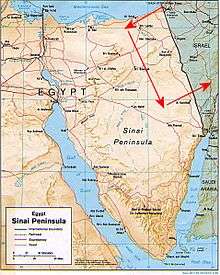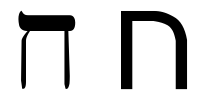Khet route
Khet route (Hebrew: ציר ה-ח') is the name given by the Israeli security forces to refer the route used by terrorists and smugglers to penetrate into Israel along its southern border.[1][2] The name given to this route stems from the Hebrew letter Khet which resembles the shape of the route.


The route starts from the Gaza Strip, goes through secret Gaza Strip smuggling tunnels below the Philadelphi Route into Egypt's Sinai Peninsula (where occasionally the militants would receive assistance from Bedouin locals), and from Sinai into Israel through a section of the Israeli–Egyptian border which had no security fence.
The route was mainly used by Bedouin smugglers, but also by armed militants seeking to carry out terror attacks, some of whom were caught by the Israeli Border Police.
On January 29, 2007 (Eilat bakery bombing) and on August 18, 2011 (2011 southern Israel cross-border attacks), terrorist attacks were carried out in southern Israel by perpetrators who got into Israel through this route.
In 2013–2014, under el–Sisi's regime, the Egyptians took steps to secure the border in the Gaza region in response to the Sinai terror attacks. These steps included the destruction of most of the 1,200 tunnels between Gaza and Sinai.[3] Also, in late 2013, Israel completed the construction of the Egypt–Israel barrier. This had the effect of significantly reducing cross-border insurgency and smuggling from Sinai into Israel.[4]
References
- Israel–Egypt Border: No-Man's Land for al-Qaeda and Hamas (Hebrew)
- Egyptian border incident: armed infiltrator killed (Hebrew)
- Egypt bans Hamas activities in Egypt. Reuters. 4 March 2014
- Lappin, Yaakov (15 January 2019). "Israel's border fence with Egypt has transformed the south". South Florida Sun-Sentinel. Retrieved 15 August 2020.